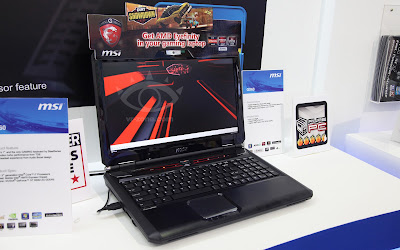Famous Taiwanese mainboard manufacturer MSI, has been quite famous lately for building the world’s fastest “Ivy Bridge” notebook and the company has apparently done it again. MSI has shown at this year’s Computex the company’s new implementation of AMD’s “Trinity“APU inside its gaming notebook line.
MSI’s Computex 2012 booth had displayed a new GX60 gaming notebook. The interesting thing about this model is that it was powered by AMD’s A10-4600M APU instead of Intel’s Ivy Bridge that powers just about every other notebook in the company’s new product line. This is AMD’s top-performing Fusion mobile part and it works at a base frequency of 2300 MHz. The processor can Turbo up to 3200 MHz and is packaged in a 722-pin micro-PGA socket called FS1 (FS1r2). The processing cores are kept fed with data by 4 MB of level 2 cache. That’s 512 KB of level 2 cache for each core.
Unlike AMD’s FX processor line, there is no level 3 cache, but being a Fusion processor, AMD’s A10-4600M comes with an integrated graphics processing unit (iGPU) that runs at a default 497 MHz, with the option to Turbo up to 686 MHz when all the 384 Shaders are subjected to a heavy 3D task. All of this is done with a maximum heat dissipation of 35 watts and, using a graphics switching technology, it will help save energy when less demanding graphics tasks are sent up for processing. MSI’s GX60 has a very powerful APU inside. It’s powerful enough to surpass discrete graphics solutions such as Nvidia’s GT 620M and GT 630M and can keep up with GT 640 in a number of scenarios.
Still, the Taiwanese company is used to build very powerful mobile gaming systems and doesn’t seem to be wiling to leave any room for the competition. Therefore MSI has selected AMD’s Radeon HD 7970M mobile GPU to improve GX60’s gaming capabilities. AMD’s Radeon HD 7970M is currently the fastest shipping mobile GPU in the world. Nvidia has just announced the GT 680M and that’s surely faster than AMD’s top mobile GPU, but notebooks with GT 680M are just being announced with shipments to begin at a later date.
Users should be well documented when it comes to mobile 3D prowess as there’s a great deal of marketing and rebranding coming from both manufacturer. On that note, you should know that the Radeon HD 7970M has a little bit less 3D power than AMD’s desktop Radeon HD 7870 GPU. Basically the HD 7970M is a Pitcairn GPU that has a frequency of only 850 MHz versus the 1 GHz frequency of its desktop brother. It comes with 1,280 shaders and 80 texture units all using GDDR 5 memory running at 4800 MHZ effective speed. Compared with Nvidia’s GeForce GTX 675M, the AMD Radeon 7970M is clearly superior while being a bit behind the recently announced GTX 680M.
It comes complete with AMD’s UVD3 video decoder, Eyefinity and the power-saving Enduro and ZeroCore technologies. Other unofficial data suggests that the Radeon HD 7970M is considerably more powerful than a GeForce GTX 580M SLI configuration, while being cheaper and more power-efficient. MSI’s GX60 gaming laptop is coming with a 15.6” screen that’s likely using a FullHD resolution. We’re eager to see the 17” version and we’re certainly hoping MSI will build one.
The laptop comes with many if the features found in the GT70 top gaming solution from MSI. The Steelseries keyboard and Dynaudio speakers are there as are the performance enhancing features such as the Qualcomm Atheros Killer NIC chip for reduced networking latency during gaming sessions and the special storage system. We would like you to pay close attention to MSI’s storage solution for the company’s gaming notebook series as this is a unique solution in the mobile gaming world and it’s currently the fastest.
This SSD-based RAID 0 hybrid storage system consists of two mSATA SSD drives that are part of a RAID 0 matrix and a separate 7200 RPM mobile hard disk drive, with up to 500GB storage capacity. The RAID 0 system reaches speeds well over 800 MB/s, while the HDD offers enough capacity for your games and files. MSI’s mobile storage solution is absolutely unique and provides performance never before seen in a gaming laptop. The GX60 uses AMD’s A70M FCH and it will be able to drive three external screens. There is no world on the pricing yet. There are some rumors that the SteelSeries keyboard and the Dynaudio speakers will be left out to make the price hit the 1200 USD mark, but we’re certainly hoping that the eSATA port will still be there along with the 17” screen model.
We consider that it would be quite unfair that AMD fans won’t be able to enjoy the same features that the Intel-based GT70 owners will be able to. We’re looking forward to review MSI’s GT70 alongside with its AMD based brother the GX60.



 6/10/2012 07:17:00 PM
6/10/2012 07:17:00 PM
 dannzfay
dannzfay

























